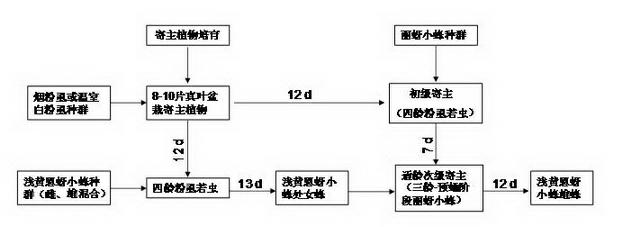Method for Producing Drones of E. japonica by Using Lepidos wasps as Propagation Hosts
A technology for E. aphid wasp drones and E. buffalo wasps, which is applied in the field of rapid and efficient reproduction of E. aphid wasp drones, and can solve problems such as scarcity of numbers, limitation of Bemisia tabaci and the like
- Summary
- Abstract
- Description
- Claims
- Application Information
AI Technical Summary
Problems solved by technology
Method used
Image
Examples
Embodiment 1
[0026] Massive reproduction of the drones of Aphidia japonica with Bemisia tabaci as host insects
[0027] The main process of mass production and reproduction of A. figure 1 Shown, the concrete operation of applying this invention to produce 10000 drones is as follows:
[0028] 1) Cultivation of host plants
[0029] Sowing, raising seedlings and planting tomatoes according to conventional methods. Cultivate tomato plants in a greenhouse with sufficient light and controlled environmental conditions. When the seedlings grow to have 3 true leaves, a single plant is planted in a flower pot (caliber 18cm, depth 12cm), and a total of 10 pots are required. When the tomato grows to 8-10 true leaves, remove the heart leaves (it helps to keep the extended growth of the leaves and prevent the plants from growing too much), and keep the leaves when they grow to about 8cm long for later use.
[0030] 2) Primary host inoculation breeding
[0031] Put the prepared tomato plants i...
Embodiment 2
[0039] The selection of different secondary hosts by the wasp A. japonica
[0040] 1 Materials and methods
[0041] 1.1 Insects to be tested
[0042] Host insect: Bemisia tabaci type B Bemisia tabaci (Gennadius)
[0043] Parasitoid wasp: Aphid spp. Encarsia sophia (Girault & Dodd); Encarsia formosa Gahan; Eretmocerus melanoscutus Zolnerowich & Rose.
[0044] Tested host plants
[0045] kale Brassica oleracea L. var. capitata . Reserve when the potted cabbage grows to three true leaves.
PUM
 Login to View More
Login to View More Abstract
Description
Claims
Application Information
 Login to View More
Login to View More - R&D
- Intellectual Property
- Life Sciences
- Materials
- Tech Scout
- Unparalleled Data Quality
- Higher Quality Content
- 60% Fewer Hallucinations
Browse by: Latest US Patents, China's latest patents, Technical Efficacy Thesaurus, Application Domain, Technology Topic, Popular Technical Reports.
© 2025 PatSnap. All rights reserved.Legal|Privacy policy|Modern Slavery Act Transparency Statement|Sitemap|About US| Contact US: help@patsnap.com

